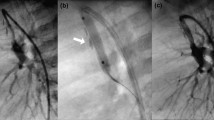Abstract
Objectives
The Blalock–Taussig shunt (BTS) operation is a cornerstone as initial palliative surgery for congenital heart disease with severely reduced pulmonary blood flow (PBF). The ideal PBF provided by BTS is crucial for an uneventful postoperative course, since excess PBF results in acute distress of the systemic circulation and insufficient PBF requires another BTS surgery. Therefore, the goal of this study was to develop a simple device to control the shunt graft flow percutaneously using a constrictor balloon connected to a subcutaneous port.
Methods
The device consists of a cylindrical balloon and an anti-bending structure extension connected to the balloon center. A PTFE vascular graft wrapped by the device was connected to a simulated closed circuit to measure the relationship between pressure and blood flow while changing the inner volume of the balloon. In a beagle model of replacement of the right carotid artery, blood flow velocity was measured in the carotid artery after saline injection into the balloon. The blood flow velocity before and after balloon inflation was compared immediately after implantation of the device and at 3 months after implantation.
Results
The device provided good flow control by inflating and deflating the balloon ex vivo and in vivo for up to 3 months in a canine model with a small graft wrapped with the device.
Conclusions
The simple device developed in this study may enable regulation of PBF through a small vascular graft and help to prevent severe morbidity and mortality in the clinical setting of BTS.




Similar content being viewed by others
Change history
27 June 2018
In the original publication of the article, the title was incorrectly published.
References
Dirks V, Prêtre R, Knirsch W, Valsangiacomo-Buechel ER, Seifert B, Schweiger M, et al. Modified Blalock Taussig shunt: a not-so-simple palliative procedure. Eur J Cardiothorac Surg. 2013;44:1096–102.
Petrucci O, O’Brien SM, Jacobs ML, Jacobs JP, Manning PB, Eghtesady P. Risk factors for mortality and morbidity after the neonatal Blalock–Taussig shunt procedure. Ann Thorac Surg 2011; 92: 642–52.
McKenzie ED, Khan MS, Samayoa AX, Vener DS, Ishak YM, Santos AB, et al. The Blalock-Taussig shunt revisited: a contemporary experience. J Am Coll Surg 2013;216:699–704.
Higashidate M, Beppu T, Imai Y, Kurosawa H. Percutaneously adjustable pulmonary artery band. An experimental study. J Thorac Cardiovasc Surg. 1989;97:864–9.
Takeuchi T, Imai Y, Sawatari K, Ishihara K, Hoshino S, Higashidate M, et al. Experience of new adjustable vessel occluder. Jpn J Artif Organs 1993; 22: 24–6.
Douglas WI, Moore KB, Resig PP, Mohiuddin MW. The adjustable systemic-pulmonary artery shunt provides precise control of flow in vivo. ASAIO J 2010; 56: 73–6.
Mohiuddin MW, Resig PP, Sexton KW, Douglas WI. Two-day control of pulmonary blood flow with an adjustable systemic-pulmonary artery shunt. ASAIO J. 2011;57:225–30.
Acknowledgements
We are grateful to Atsuko Ueda, and Akiko Iritani for their help with management of animals and preparation for surgery. The results of this study were used in an application for a Japanese patent (JP2014/193286) on September 24, 2014.
Author information
Authors and Affiliations
Corresponding author
Ethics declarations
Conflict of interest
The authors declare that they have no conflict of interest.
Funding
This work was supported by a Grant-in-Aid for Scientific Research from the Ministry of Education, Culture, Sports, Science and Technology (26870721).
Rights and permissions
About this article
Cite this article
Motohashi, Y., Shimada, R., Sasaki, T. et al. Development of a simple device enabling percutaneous flow regulation for a small vascular graft for a Blalock–Taussig shunt capable of flow regulation: complete translation of a review article originally published in Pediatric Cardiology and Cardiac Surgery (154–159, 2016: vol. 32). Gen Thorac Cardiovasc Surg 66, 145–149 (2018). https://doi.org/10.1007/s11748-017-0860-3
Received:
Accepted:
Published:
Issue Date:
DOI: https://doi.org/10.1007/s11748-017-0860-3




